
An “optimal” facility with buffered bike lanes in both directions, but no auto parking on 28th Avenue through its busiest commercial district, probably isn’t in the cards for the 20s Bikeway, a city project manager said this week.
The most comfortable biking plan “achievable,” city project manager Rich Newlands said in a presentation Tuesday to Portland’s Bicycle Advisory Committee, is a design that hasn’t been seen before in Portland or almost anywhere else: a shared lane in one direction, marked by green-backed sharrow stencils, with a buffered bike lane in the other direction.
“We’re going to run into this situation in many other sections of this bicycle network that run through these relatively constrained commercial districts.”
— Rich Newlands, 20s Bikeway project manager
Newlands referred to the plan as a “couplet,” since a nearby neighborhood street would also be improved into a neighborhood greenway that would let people avoid the shared lane by venturing out of direction a few blocks (similar to plans to create a neighborhood greenway on N Rodney as a low-stress alternate to N Williams Ave.)
The buffered lane would require parked cars to be removed from one side of 28th between Interstate 84 and Stark Street, Newlands said, probably the west side. By comparison, an “optimal” biking plan would require removing parking from both sides of the street, something Newlands said would probably be impossible due to anticipated resistance from businesses on 28th.
But at this point, the pushback is only assumed: Newlands said Tuesday night he hasn’t even begun direct outreach to adjacent businesses. (For a sense of what business owners on the strip think — it’s nuanced — you can read our coverage from December.)
Newlands said the compromise, whatever it is, is likely to become a “model” for bike facilities on the city’s other commercial streets.
“We’re going to run into this situation in many other sections of this bicycle network that run through these relatively constrained commercial districts,” he said. “If we get it wrong this is going to go down in flames.”
Newlands conceded that with 7,000 cars a day, 28th would “certainly warrant separation” between cars and bikes if there were room. For the many people uncomfortable biking in mixed traffic on 28th, he said, the city could create a “couplet” using 30th Avenue as a lower-stress northbound detour around the stretch in question:
But Newlands said he’s unsure whether people who want to improve 28th feel that this plan is “not just acceptable but worth supporting.”
“What I’m trying to gauge is whether people agree that this is a good type of facility,” Newlands said. “It does address many of the basic goals of this project. What I don’t know and what I’m not prepared to say here tonight is is it worth the tradeoff of that amount of on-street parking.”
If bike advocates don’t turn out to advocate strongly for this proposal, Newlands said, he’s “pretty certain” that “we will end up with the fallback that the corridor will bypass 28th and we’ll try to do as much as possible with traffic calming.”
The 20s Bikeway would be the first on-street bikeway to run the full length of the city from north to south. It’s part of the 2030 Bike Plan, which set a goal to make biking “more attractive than driving for trips of 3 miles or less.”
The neighborhood has a dense, walkable row of storefronts because, unlike the nearby parking-dominated commercial strip on Sandy, it wasn’t built with cars in mind. Its anchor buildings went up in the 1910s to serve riders of a streetcar line that then ran west on Ankeny and turned north on 28th. Unlike other streetcar routes such as Hawthorne and Burnside, 28th Avenue was never widened to make room for more cars — leading to today’s narrow range of options.
Newlands also presented renderings of three other options for the bikeway on 28th. First, the “optimal” bike facility with buffered bike lanes in both directions:
Then, a four-foot bike lane on both sides of the street:
Finally, a two-way bike lane on the west side, also only four feet wide and with no buffer between the lane and the right doors of parked cars:
Newlands also mentioned that it would be possible to remove one direction of auto traffic from the street in order to make room for comfortable biking in both directions.
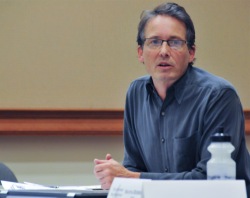
Advisory Committee meeting last fall.
“I think it’s arguably a harder thing to pull off than getting rid of the on-street parking,” he said. “The two nearest collector streets that you could utilize are 20th and Cesar Chavez.” Another option would be to divert cars to a side street such as 30th, an option Newlands dismissed as politically impossible. “Imagine the conversation of having City Council take someone’s local street and turn it into a collector street,” he said.
Members of the Bicycle Advisory Committee seemed sympathetic to Newlands’ concerns but expressed little enthusiasm for the proposal. Committee Chairwoman Suzanne Veaudry Casaus said she stood ready to advocate for better biking through the area but wished she hadn’t seen a picture of the “optimal” facility before Newlands showed his rendering of the shared lane.
“For the willing but concerned,” a subset of riders Veaudry Casaus considers herself one of, “this was painful.”
Vice Chair Ian Stude suggested that the city consider moving the buffered bike lane to the east side of 28th, where most of the businesses sit, so their owners would be more likely to get the benefits of increased bike traffic past their storefronts.
“It gets us one step closer to an example of what we’re shooting for here,” Stude said. “It gets us to a better success story, or at least a photo op.”
More info on the 20s Bikeway Project:
– Past coverage on BikePortland
– PBOT’s official project page
Correction 2/20: An earlier version of this post overstated the traffic volume on 28th Avenue.




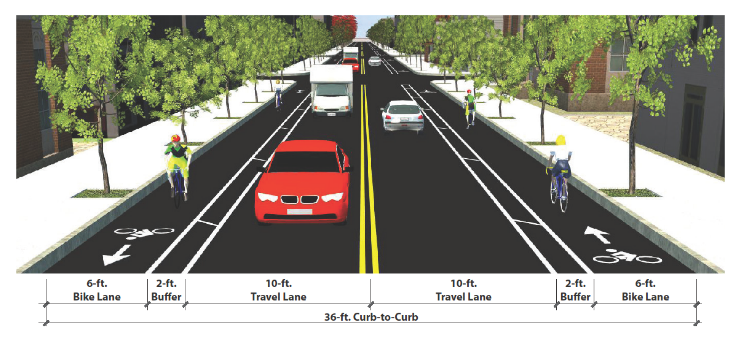
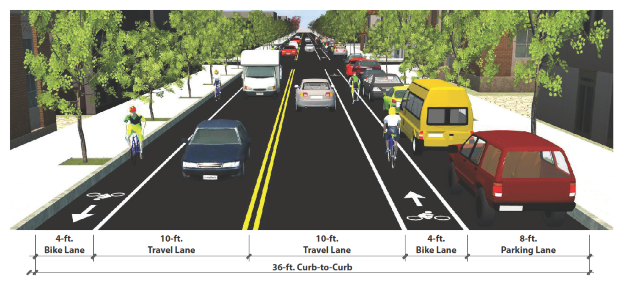
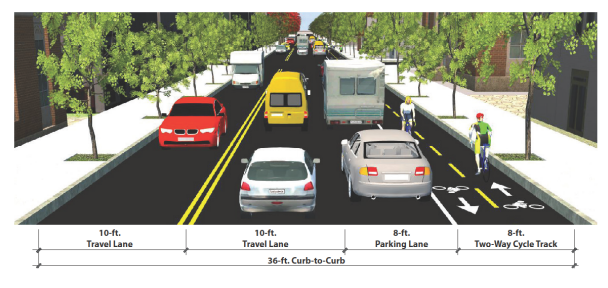

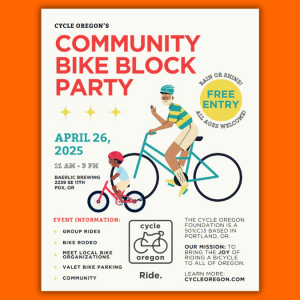
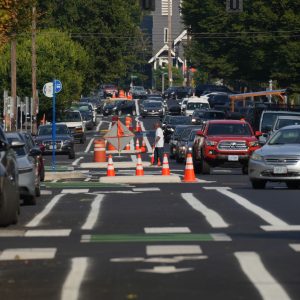
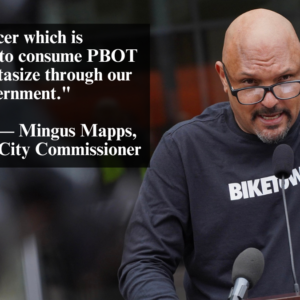
Thanks for reading.
BikePortland has served this community with independent community journalism since 2005. We rely on subscriptions from readers like you to survive. Your financial support is vital in keeping this valuable resource alive and well.
Please subscribe today to strengthen and expand our work.
I don’t know why they call those lanes “buffered.” All they are “buffered” by is air. I think of a “buffer” as a protective layer that prevents contact… not something these buffers are up for.
Those are in fact “buffered” bike lanes, 3-4 feet of paint between the bike lane and travel lane. PBOT has been adding these buffers throught the city, like on NW 16th and N Williams near Rose Garden.
What you are thinking of “protected” bike lanes, with a curb, parking, planters, bollards separating those on bicycles from those in cars.
bike lanes are among the most successful infrastructure in pdx. for example, the increase in traffic on williams-vancouver resembles al gore’s infamous hockey stick. there is also substantial evidence that buffered and door-zone free bike lanes are associated with enormous increases in mode share. and finally, research by dill at otrec indicated that the “interested but concerned” rate conventional bike lanes about the same as protected lanes (from the perspective of comfort and safety).
The presentation you mention from Jennifer Dill is linked here:
http://otrec.us/project/446
The working paper I referred to can be found here:
http://web.pdx.edu/~jdill/Types_of_Cyclists_PSUWorkingPaper.pdf
Spare_wheel, what numbers are you drawing on? Seems like the most relevant info on this question is the final bar chart, on p. 16 of the paper you link to, which shows that there’s a slightly bigger difference in perceived safety between conventional and protected as there is between no bike lane and a conventional bike lane. Also see the second chart on this post I did for my other gig, based on the same Dill research paper — similar finding for the interested but concerned.
The descriptions of infrastructure there are very vague. I prefer the more detailed descriptions in Figure 6 of Dill’s working paper.
In this figure the interested but concerned gave a conventional bike lane on a 25-30 mph street a rating of 2.7 out of 4. Protected bike lanes were rated 3.0 and 3.2 (albeit on streets with higher speed limits). Given that the majority of streets in Portland have speed limits of 30 or less I think Dill’s results argue that the interested but concerned are comfortable with conventional bike lanes on a typical road. I wonder how the interested but concerned would have rated an 8-12 foot buffered bike lane versus a protected bike lane on a 25-30 mph street?
Thanks. Still, seems to me you’re stretching a little to compare the 2.7 in the 25-30 mph category to the 3.2 rating in the 30-35 speed category, especially since respondents so clearly express increased preference for physical separation when they’re comparing apples to apples in the 30-35 category.
It does seem as if it’s hard for stated preferences in a phone survey or whatever to accurately estimate the actual experience of riding in a lane, though, which is part of what’s persuaded me about your case that buffered lanes are underrated.
a bit of a stretch, perhaps. i doubt that a protected lane would rate much higher on a 25-30 mph road versus a 30-35 mph road.
Agreed. Dween!
I agree… these lines of paint that fade and rub off in a matter of months are hardly buffered bike lanes.
“America’s best biking city…?” Whatever.
Reminds me of the new design for Williams–the four-block stretch without a bike lane. I feel like we’re moving backward, not forward.
David,
Just FYI, from PBOT’s perspective, to create a bikeway – any type of bikeway – on dense commercial streets like Williams or 28th is a huge step forward.
Yeah, I get that. And I guess if this model ends up working out, it could have the potential to be rolled out to places like Alberta or Mississippi. We’ll see!
It is definitely moving forward compared to what is there now (ie. parking in both directions and no bike facilities at all). It’s just not moving forward as far or as quickly as many would like.
I feel bad for Rich. He has a tough job trying to sell less-then-optimal bike infrastructure in a still-autocentric city with high aspirations that it doesn’t seem capable of delivering on (yet). I gave him such a hard time at The King Neighborhood meeting about Williams/Rodney the other night that I felt compelled to apologize afterwards. But I stand by my argument that giving the “interested but concerned” segment safe access to our commercial corridors is the only way we’re going to get close to a 25% bicycle mode share. Most people with children, let alone the elderly or the just-plain-nervous, are unlikely to want to deal with the mixing zones on Williams or a shared lane on 28th where street design leaves us so dependent on the good/patient/sober/responsible human behavior of road users operating 3000 pound vehicles.
It continues to be a chicken/egg situation. Won’t get more bikers without better facilities (although I don’t think this is entirely true), and won’t get better facilities without more bikes (which also is obviously not entirely true).
Andrew, I agree with your assessment, and would add that I have been commuting for 20 years… I’m not exactly new to cycling on city streets, and I don’t feel good (for obvious safety reasons) about these motor vehicle and bicycle mixing zones. It’s one of the worst ideas PBOT has come up with.
What further evidence do we need that a percentage of motors will always be irresponsible in their driving behavior. Let’s design roads that work for the most vulnerable users.
And start charging people to park on the streets, it’s public space. IMO it’s poor planning to use it for free parking. If parking space is going to be created/allowed, then collect a fee.
almost all of downtown is in fact set up this way though.
You should run for office on your last paragraph.
“Most people with children, let alone the elderly or the just-plain-nervous, are unlikely to want to deal with the mixing zones on Williams or a shared lane on 28th”
Do you have any evidence to back up this claim?
He does have a difficult job. It seems that citizen’s opinions are changing faster than they can keep up. In the case of the 50’s bikeway, the initial outreach was so long ago that the current designs are not up to snuff. We would prefer more diversion than is actually called for but they do not believe us. He does have a tough job…..but PBOT is very forceful when it comes to parking removal, they do NOT want blow back and if the locally preferred option is parking removal or diversion you have to prove it to them.
Wanting diversion on a collector street and getting such a violation of City policy are two different things. Particularly for a street with emergency vehicle access restrictions (as any of the few roads that cross a barrier like a freeway trench will be).
I think if the parallel street was built to full neighborhood greenway standards (with diverters, turned stop signs, traffic calming, enhanced crossings at major streets, etc.), it would be a valuable addition to the city’s gridded bike network. I could see myself occasionally skipping the hassle of riding down 28th if I have no business of stopping there to take the greenway instead. Same thing applies to Rodney vs. Williams/Vancouver.
If we can’t remove both lanes of parking (too politically expensive) or move curbs (too fiscally expensive), I’d rather see a solution that utilizes advisory bike lanes and puts in diverters at strategic points. Also, I mentioned to Rich at the BAC meeting that those centerlines need to be removed, if nothing else.
I love neighborhood greenways, but the convoluted route of this one would be problematic for me. I think it is a pleasant alternative and likely to be very valuable to the neighborhood, but it seems not very user-friendly to many cyclists
There need to be both choices in each corridor. In North Tabor we have the Couch-Davis-Everett Greenway which has worked for a generation, but commuters generally still take Burnside westward down the hill since it is direct and fast. We want upgrades to the greenway including traffic calming, but Burnside Buffered Bike Lanes were approved unanimously by our board as part of our comprehensive growth plan letter to the city. We understand that convoluted bikeways are good for going to school, family outings or group rides but if you are going from point A to point B a direct and safe route is needed. This plan is an OK compromise since the parking lane could be converted later on to a bike lane if we so choose once our modal split ticks up.
Couch-Davis-Everett has not yet had neighborhood greenway upgrades.
i think keeping the buffered bike lane and upgrading the super sharrows to a full advisory bike lane would be a very good idea.
Yes: diverters, diverters, diverters.
that first option is all sorts of awesome. it’s a facility i would go out of my way to use.
While I know the shared lane thing seems terrible to many people and it doesn’t seem to jibe with our commitment to create bikeways that appeal to the “8-80” demographic, I think we should remember Rotterdam.
When I visited last year I saw a street where cars were “guests” and people on bikes (young and old) calmly rolled down the road with people driving slowly and respectfully behind them.
Read the story here and see photos of what it this “fietsstraat” (bike street) looks like below…
Yes, people are much more courteous in Rotterdam, but I think if PBOT is going to do this type of treatment (and they already have committed to it on Williams), then they must also commit to aggressively regulating driving behaviors. “Cars are Guests” signs would be cool. As would installing special N’hood Business Traffic Safety Zone policies (I just made that up). Those policies could include 15 mph speed limits, or a “do not pass” law or built environment/design stuff like pavers, speed tables/humps, speed reader boards, and other aggressive traffic calming measures.
the rotterdam shared lane is a terrific example of the kind of infrastructure that is achievable today and would have a huge positive impact on cycling in pdx.
Yes! If you can’t go in one direction (full cycle tracks), then the option is to go in the other and create a full shared space environment.
But I can guarantee you that street in Rotterdam is not carrying 7,000 cars per day.
Come on Nick! You’re sounding more and more like an old-school engineer or PBOT staffer by the day. ;-).
Why do you think 28th carries more cars than the Rotterdam street?
hmmm… hmmm…
Because in Rotterdam bicycling is so comfortable and efficient that it is a more competitive transportation choice.
Whereas on SE 28th – and almost every other street in Portland – driving a car is the most convenient, safe, and efficient mode of travel.
We should not let existing auto volumes constrain our vision for what needs to be done to shift the status quo.
I personally like the idea of a completely shared space, it’s gunna have to happen at some point reguardless, so why not start now.
Unlike the other options, if the design doesn’t work there is no turning back. If the shared lanes don’t work, we can always fall back and do one of the other options later since there is no substatial infrastucture changes with the shared lane option. After all the shared lanes option is mostly paint and signage (perhaps a few speed bumps designed so that the “bump” is in the outter 3′ of the lanes, but absent in the middle 3′ or 4′.
Add the green ways a few blocks off for the more timid riders, but this would be a great place to try the shared bike lanes.
haha! yes. I was only pointing out the volumes to note that the Rotterdam design would break down at 28th’s traffic levels. Clearly, the answer is to change the volumes, not to give up on the safe street.
Mainstream traffic engineering and planning are very wary of actively managing volumes of cars on our heavy streets. Planners and engineers have gotten amazingly good at controlling volumes on our Neighborhood Greenways and they’re willing to push the envelope on road diets. But they’re not yet at the point where they’ll say 28th needs to go from 7,000 to 4,000 cars.
I really hope they are “Willing to push the envelope on road diets.” We want one. I also do not see them able to lower traffic volumes at this point. If the Gulch was not there, or we had a grid of WIDER residential streets like mid-western cities like Milwaukee, but in this bottleneck we will need to wait until the number of auto’s in the “trendy dense inner east area” ticks down. Maybe start charging for parking as part of the project?
I actually like this idea, if at the leasry in the really space constrained commercial areas where people are already driving slow.
There isn’t much about even a green sharrow that is going to get people over the edge when it comes to deciding to bike in the street vs not at all.
The first time I saw the “cars are guests” signs in your post about Rotterdam I knew these needed to come to Portland. Every neighborhood greenway needs these signs. Anytime we have a shared environment (like Williams or this proposal for the 20s bikeway) these signs should be present. I feel these signs would act as a reminder that bikes don’t just belong, but that they are one of the top means of transportation and part of what makes this city great and livable. Heck, why don’t we have a contest to design Portland’s “cars are guests” sign and then start a Kickstarter to fund the manufacture and installation?
This would need _heavy_ law enforcement presence for the first year or so to be successful. I doubt we will ever get enough legal “teeth” engaged to make motorists respect this kind of street design.
For neighborhood greenways:
Set up speeding and red light cameras and a sign underneath explicitly stating that the only cars that belong on this street are residents of this neighborhood – ALL OTHERS WILL BE RECORDED!
Stop the high speed cut throughs dead!
what’s the rush? Gotta start somewhere. I LOVE cars are guests signs.
The main difference that I see is that the PBOT shared space has a door zone, while the Rotterdam example does not.
the sharrow indicates that cyclists can/should use the full lane. if this message is reinforced by signage and forceful traffic calming i believe kind of facility can appeal to most current and potential cyclists.
Unfortunately we have Stakeholder Advisory Committees, which have which represent all interests and have a large say in street designs. There’s no way a Rotterdam-style setup would pass muster with a SAC. Sometimes democracy means we don’t get what we want.
I love the Rotterdam example but it seems like it would be more applicable to certain streets downtown rather than an arterial like N Williams, which has a relatively high volume of traffic. 28th also has pretty congested auto traffic — many times I’ve had impatient drivers try to squeeze by me with mere inches to spare. I would never ride with a child in such a scenario and I doubt that business owners in that corridor would be thrilled by the idea of setting up a bunch of obstacles to the perception of free-and-easy car access. The removal of one lane of parking is already going to be very controversial, right?
The Dutch criteria deciding whether bikes can operate in mixed traffic requires three elements:
Speed limit should be 30 km/h (19 mph), or less
Traffic volumes should have 5,000 motor vehicles per day, or less.
There should be no centerline or car lanes marked.
They have these all over The Netherlands, not just Rotterdam
The state legislature determines statutory speed limits in business districts, and that speed is currently 20 mph. For a street to be posted 15, it would need to be 2-way with less than 18 feet of roadway width. Not exactly a collector level street with thousands of daily car trips.
This seems like PBOT’s first test of their commitment to “Vision 0”
Sigh: That last sentence, the quote, is telling. What would make the *best* story or photo op would be authentic, measurable safety improvement. Instead, the emphasis seems to be on creating the _appearance_ of same.
I completely agree! However, to put that quote into context, we were discussing alternate options for the “couplet/one buffered lane” concept. If the neighborhood will only tolerate the removal of parking from one side of the street, the suggestion was to remove the parking from the side with more commercial activity rather than less. Then you have a higher class of bicycle facility that’s at least half of the model we are looking for on our commercial corridors — plus a much more compelling visual to help sell the concept (half or whole) to businesses and property owners on other streets.
Well dang, I’ll support this option. In this corridor, I agree with Newlands about the political will to remove car parking along both sides of the street. At the very least, a buffered bike lane not in the door zone would be great going one direction. Hopefully car traffic going the other direction can be calmed enough to make it a nice facility. 20th and Chavez are close enough that through car traffic would hopefully divert to them if speed bumps and other calming measures were installed.
As I mentioned at the SAC meeting for this project, the protected bicycle facility needs to be installed for the uphill (northbound) direction of travel; it makes sense that bicycles could potentially share a lane in the downhill direction, but it benefits nobody to force that in the uphill direction. And yes, I realize that the “hill” is slight if you’re on a fast, light bicycle; but on a cargo bicycle weighing 50+ pounds, or for novice riders, it can slow you waaay down.
The current proposal seems to put the buffered bike lane in the downhill direction for reasons that don’t quite make sense to me.
This should be a deal-breaker; either the buffered lane is in the uphill direction, or go back to the drawing board…
Newlands said Tuesday that the incline is so slight that it’s not worth worrying about. Where’s the steepest slope in your observation?
Yes, michael you mentioned that these types of facilities aren’t used in the US, but there are a quite a few places where there is a bike lane for uphill traffic and no lane for downhill. If the hill is substantial enough (which this clearly is not) this set up can work fairly well.
I worry about it. I’m not a strong rider: even that slight incline affects my speed and adds more pressure in a section that is alteady tense.
This wasy first thought also. Making bikes haul uphill with impatient motorists revving behind them is not a recipe for comfort.
the image you have painted of impatient motorists revving is simply not my experience when i take the lane in inner SE portland. if priority is given to cyclists via signage and traffic calming i think that this type of hypothetical behavior is even less likely.
until you get smoke screened!
Perhaps his bikes are toys? Put 100 kg on it and a hill is a hill. If the sheltered lane is one way, it’s gotta be uphill.
I’d also much rather have the bike lane going uphill. I’ve had some scarily close passes from drivers in that section and it’s a stressful area to navigate. Going downhill is faster and easier to keep up with cars.
As a resident who lives near 28th and bikes that stretch frequently, I can definitely get behind the “best achievable” option near the top. It’s a big improvement that can be built on later. Definitely keep the bike only lane on the east side of the street.
On a differnent note, I wish there was some way to educate out-of-towners about some of our bike infrastructure (ie. Sharrows, bike boxes, shared lanes, etc.). Portlanders of any duration seem to learn quickly how to deal with the high numbers of bikers pretty well. I get very nervous when people from rural areas and out-of-town truckers come to Portland and are not familiar without unique rules.
As one of the few home owners on this stretch of 28th, I think this approach may be the best middle ground. I’m doubtful that there will ever be agreement to remove all parking, both from the business owners and from neighborhood residents (as a lot of the parking for these businesses will spill over onto the residential side streets).
My biggest concern is that doing the couplet without signaled crossings of the major cross streets is going to be counter-productive. Depending on the time of day, crossing Glisan, Burnside, and Stark at 30th can be difficult and I would think would be even more uncomfortable for the set of riders who are uncomfortable riding in traffic on 28th. I don’t recall the budget for the project, but I don’t seem to remember it being big enough for providing signals at intersections.
One other thought is that part of the reason 28th is so congested is not just because it is a feeder, but also because there are a lot of backups resulting from cars trying to park on 28th. Maybe removing more parking would actually improve the flow of traffic on this stretch?
I’m on the Stakeholder Advisory Committee. The budget for the entire project is 2.5M, so there is money available for some full traffic signals, and lower cost options like flashing beacons and HAWK signals.
So far, we’ve been holding off on talking about crossing details until the route closer to being finalized. The intent is to provide improved crossings, and there will be a treatment at 30th & Burnside, if that is part of the final route.
each full signal is estimated to cost $250 k. that eats up budget very quickly. Miles of markings aren’t cheap either. (removing old markings costs a lot also)
While I think the preferred plan is s sound compromise, I’m really intrigued by the two-way cycle track – particularly because the “wrong way” riding is actually against the direction that cars are facing. This actually helps mitigate the door zone in two ways:
1. The bicycle operator can make eye contact with the car passenger easier.
2. If contact is made, it’s in the direction the door will close – not the direction that will act as a dead stop.
Great points! I would add:
3. it is facing the passenger side door which should see significantly less traffic
The biggest problem with two way cycle track on one side of the street is how to handle turns on and off the cycle track – in particular turning left, every cyclist wishing to do so has to cross three lanes of traffic each one going the opposite direction, each at a different speed than the last. It’d be like playing Frogger for realz at peak times. One bad call, and just like Frogger—splat.
All I see is the potential for some extreamly dangerous cycling conditions. Cyclists hitting cyclists, cars hitting cyclists, cyclists hitting parked cars and still being doored (we’ve all looked eye to eye and still found it didn’t work as we expected), and perhaps the worst would be combination of cyclists head on with cyclists (perhaps as one is doored or evades a potenial dooring) then they end up getting hit by a car after falling into the auto lanes.
I’m intrigued. Of course the ideal would be to remove parking on both sides, and this is a pretty busy street for a sharrow lane, BUT part of what we’re trying to do here is experiment and see what works, and that may be different in an American city than a European one with different culture and drivers. Let’s do it.
If it works, it could be better than having bike lanes on both sides (second illustration above) since one of those 4′-wide lanes would have to be in a door zone. If I’m riding next to parked cars I’d rather have the whole lane.
I’m also intrigued by the two-way bike lane shown above. What if we tried both options, with one solution on the stretch north of Burnside, and another on the stretch between Burnside and Stark? The one with the shared lane would need to be used on whichever part has the lowest traffic counts in the lane that would be shared.
The 2-way cycle track looks ok in a section, but it would very unwieldy and unsafe to get bikes across the motor vehicle lanes. IMO, this make putting in a short section as an experiment a tough sell.
The proposal goes only half way…make the entire stretch a new kind of multimodal shared street: slower speed limit, special surface, signage. What Michael shows from Rotterdam is an example of what has been done all over Europe. I would keep parking on both sides and/or consider widening the sidewalks as well, maybe dropping curbs altogether, like in Director’s Park downtown. Congestion will help slow things down and make the street safer; its what every commercial district wants and needs. So bring it on! Folks in a hurry will figure out other ways to make their trip by car or get on their bikes!
I love it Lenny! Raise the asphalt up to curb height, center-drain the street, keep parking (add meters, though!) on both sides, remove all striping, and add signs saying shared street -20mph. You may need a couple of bollards to keep parking cars off the sidewalk, but I bet the utility poles, pay boxes, street trees, etc would be adequate.
The difference in grade is important. Even a strong rider can perceive a very slight difference in grade, that is invisible to a car driver. Having the shared lane going down hill will be much safer to help people cycling to maintain similar speeds to motorized traffic. A 20 MPH limit would be good, but certainly no more than 25. And before you red-hot racers pile on; you can afford the light frame, you can afford a speedometer; and I’m sure there’s an I-Phone app for that…
Mr Newland, you all have gotten it wrong already. Before even facing a little pushback from a few businesses. . . you roll over and give up. Sorry, this just isn’t good enough.
Run for office Charley, be the change you want to see.
Surely if you are removing one lane of parking, that leaves enough room for a bike lane in each direction?
If a parking lane is six feet wide – that would leave room for two three-feet bike lanes on either side of the road.
Or am I missing something?
A standard parking lane is 8 ft not 6; a standard bike lane is 4 ft not 3.
i’m pretty sure that pbot best practice proposes a minimum width of 5 feet with 6 feet being the de facto standard for a conventional bike lane. it’s also pretty obvious that pbot now favors buffered lanes over standard lanes.
Minimum bike lane is 5 feet. Standard is six. Preferred is 2 m = 6 ft 6 inches.
Adam, the configuration you describe is on the table and shown in the images from the story.
The general attitude is that 4 ft bike lanes are inadequate, in particular next to parking (a car door will take up most of that 4 ft when open).
3′ is a scary-narrow bike lane, and even 4′ is considered pretty narrow. I personally would avoid a 4′ bike lane squeezed up against parked cars.
My ONE bike related ER visit as an adult I got car-door in a conventional bikelane on NE Glisan. Four foot bike lanes should NOT be built anymore unless there is no other choice and it is not in the door zone. It is like striping an unprotected crosswalk….it can make the situation more dangerous.
they seem to have forgotten the parking meters.
i say no. 28th is too important to compromise in this half-assed way. we’ll suffer with this for the next 20-30 years and people will wonder why bikes don’t use it and still complain about 28th.
Well. This is cool for someone like me, who already feels okay riding 28th. I’m actually stoked to use it. Is it going to attract the “less confident” though? Doesn’t really seem like it would, since it’s still a mix of different users.
Is this a freight route also? Saw two semis yesterday right outside of Beulaland at about Davis heading north, with a guy on a cargo bike in between the two.
Hoping it’s the first step to a great facility someday.
Would it be possible to make 28th a one-way street going North & either 30th or 26th a one-way street going South – it’d then be easier to fit in complementary bike lanes…
Creating a Bike Street (Cars as Guest) with appropriate very visible signage, road diet and speed-reduction measures on a road like 28th would indeed be an interesting experiment.
Besides the signage it’d probably be ideal for there to be Super Sharrows with a continuous line of green paint. Oakland and Long Beach in California have implemented these on busy arterials–video of Oakland example below:
http://youtu.be/tXz92E6l628
Video of Long Beach example below:
http://vimeo.com/5367991
That’s obviously really not an 8-80 lane at all, but on a comparatively smaller street like 28th Ave could be more effective along with the other measures mentioned. And the continuous green strip would reinforce bikes’ priority.
I noticed flyers going up today on 28th warning the neighborhood about this and a call to action to block any changes. Interestingly, it claims the BTA got the grant and that parking in both directions will be removed.
It doesn’t say at all who is behind this, but says there will be a meeting at Coalition Brewing on Weds Feb 19th from 1:30-3:30, if anyone is interested. Might be interesting for BikePortland to cover.
Does anybody know what visual graphics program they use to show the detailed cross section?
This looks like something made in SketchUp. You can tell by the not very attractive default bicyclists figures.
Visual graphics with road cross section is very helpful. I think these should display a beer delivery truck and a UPS truck parked in the buffered bike lane and riders having to merge with traffic to go around these.
The shared lane of cars and bikes is currently the situation I encounter when riding on this street with some green paint added. I don’t think this green paint will change the standard game of leap frog we normally engage in with cars on 28th during North/South travel – pass them on the right at stops, they pass back on the left as soon as they can. I don’t think cars patiently waiting behind cyclists if they can pass when driving (safely or not) and bikes not green-flagging up to the front of the line at stop lights is ever going to change with signage alone.
Portland: America’s Bike Capitol.
This plan is good in the way that you feel good when you stop hitting your head against the wall.